BUS 500: Business Research Design and Methodologies Analysis
VerifiedAdded on 2021/02/21
|12
|3368
|22
Report
AI Summary
This report provides a comprehensive overview of business research design and methodologies, focusing on qualitative research techniques to analyze business strategic practices for achieving competitive advantage. It explores various research methodologies, including quantitative and qualitative approaches, research philosophies (positivism and interpretivism), and research approaches (inductive and deductive). The report delves into research design, specifically exploratory research, and discusses data collection methods, including primary and secondary data techniques. It also covers data analysis, emphasizing qualitative data analysis and thematic analysis, and addresses sampling techniques such as simple random sampling. Ethical considerations are also highlighted, underscoring the importance of honesty, confidentiality, and intellectual rights. The report aims to identify elements affecting employee motivation and job satisfaction, employing qualitative research to develop hypotheses and understand the impact of motivated staff on productivity, using examples from companies like Telstra Corporation Limited, Woolworth, and Aldi.
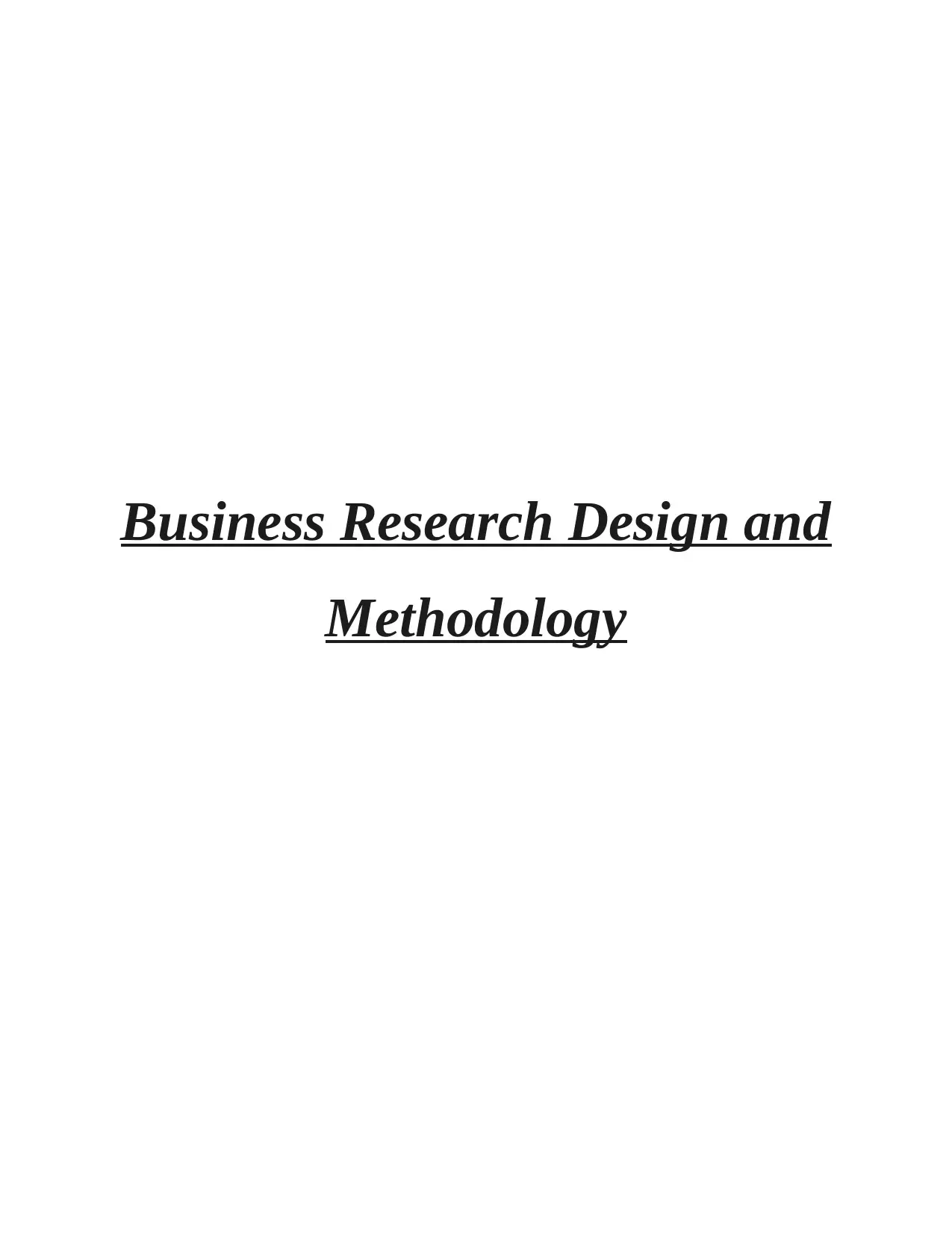
Business Research Design and
Methodology
Methodology
Secure Best Marks with AI Grader
Need help grading? Try our AI Grader for instant feedback on your assignments.
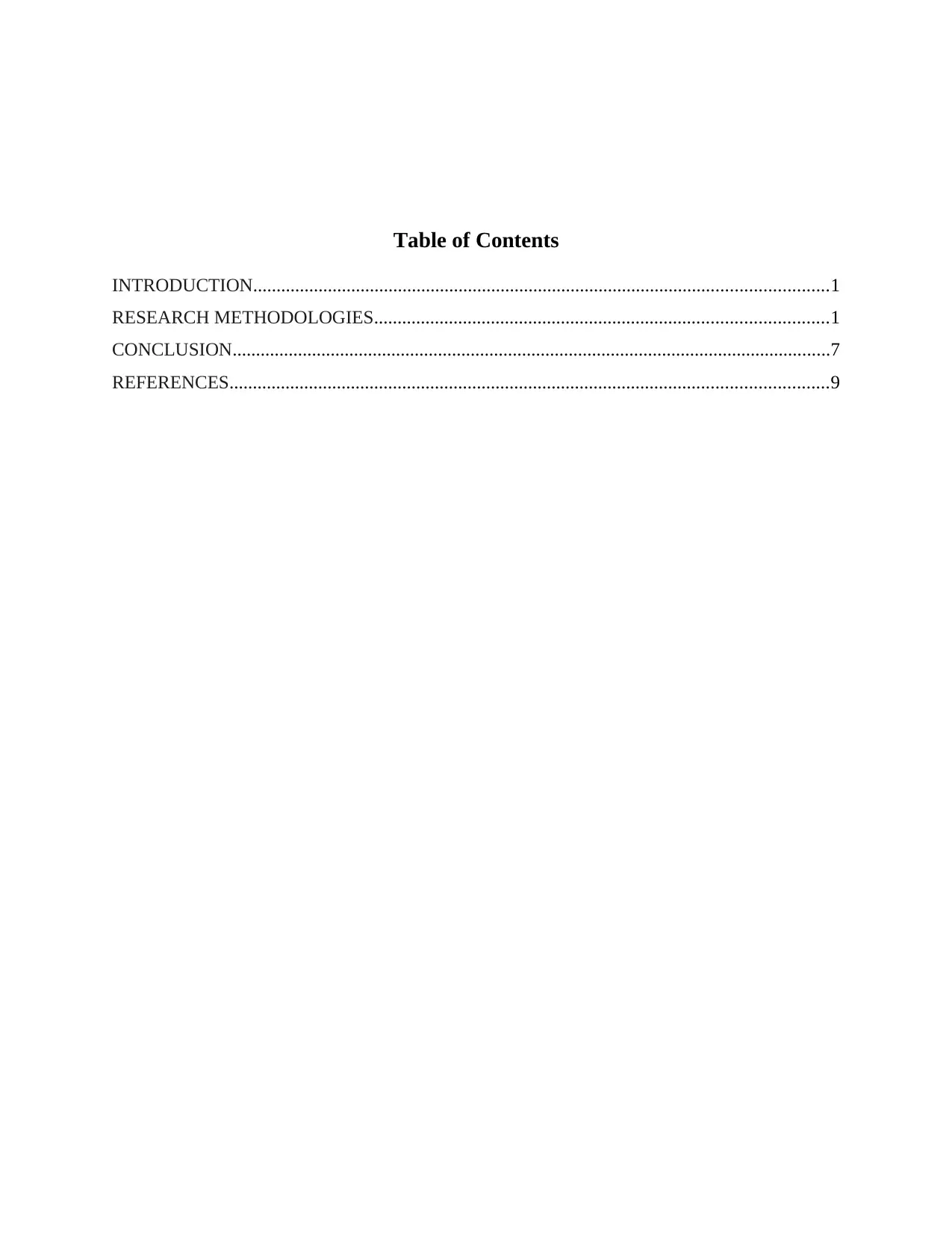
Table of Contents
INTRODUCTION...........................................................................................................................1
RESEARCH METHODOLOGIES.................................................................................................1
CONCLUSION................................................................................................................................7
REFERENCES................................................................................................................................9
INTRODUCTION...........................................................................................................................1
RESEARCH METHODOLOGIES.................................................................................................1
CONCLUSION................................................................................................................................7
REFERENCES................................................................................................................................9
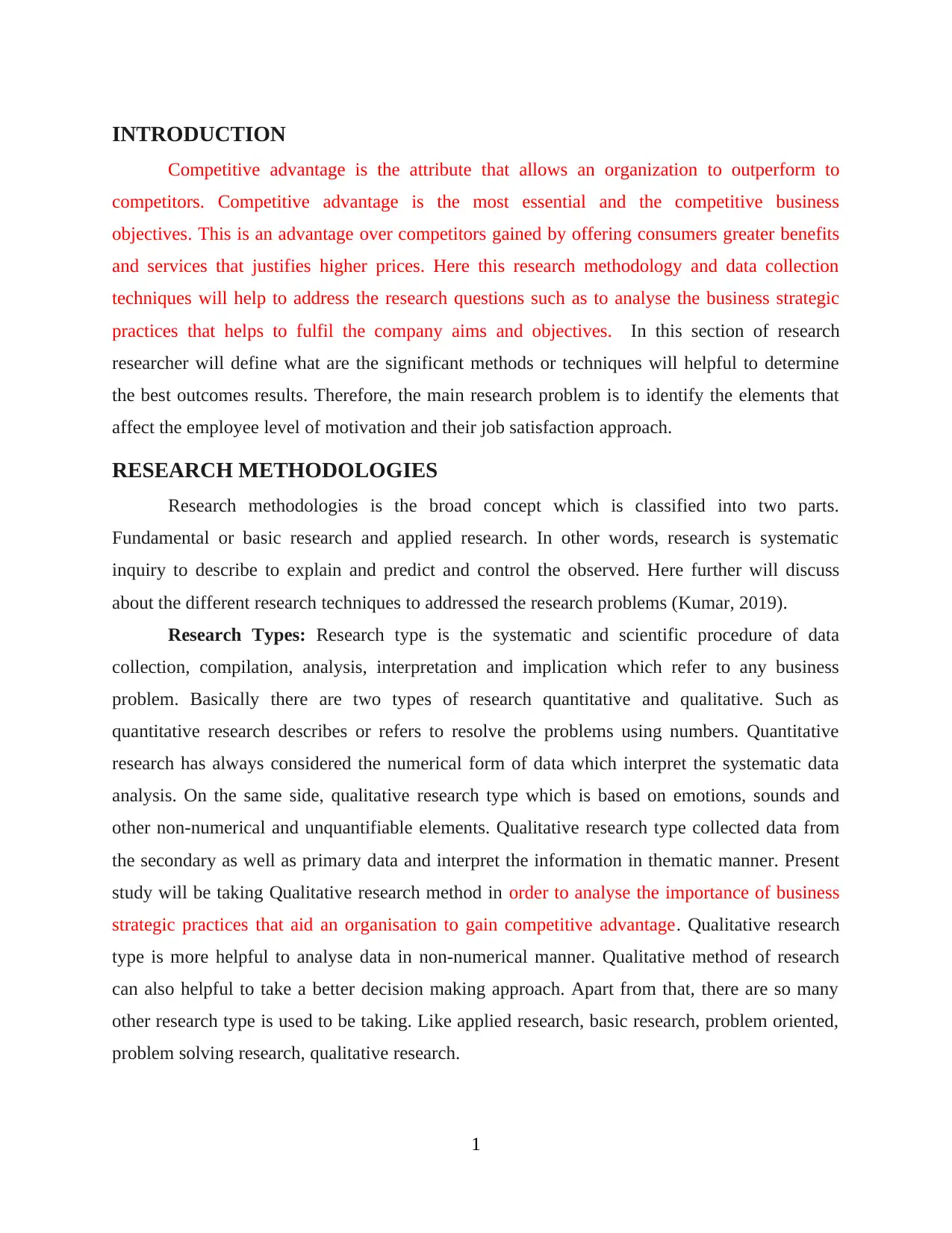
INTRODUCTION
Competitive advantage is the attribute that allows an organization to outperform to
competitors. Competitive advantage is the most essential and the competitive business
objectives. This is an advantage over competitors gained by offering consumers greater benefits
and services that justifies higher prices. Here this research methodology and data collection
techniques will help to address the research questions such as to analyse the business strategic
practices that helps to fulfil the company aims and objectives. In this section of research
researcher will define what are the significant methods or techniques will helpful to determine
the best outcomes results. Therefore, the main research problem is to identify the elements that
affect the employee level of motivation and their job satisfaction approach.
RESEARCH METHODOLOGIES
Research methodologies is the broad concept which is classified into two parts.
Fundamental or basic research and applied research. In other words, research is systematic
inquiry to describe to explain and predict and control the observed. Here further will discuss
about the different research techniques to addressed the research problems (Kumar, 2019).
Research Types: Research type is the systematic and scientific procedure of data
collection, compilation, analysis, interpretation and implication which refer to any business
problem. Basically there are two types of research quantitative and qualitative. Such as
quantitative research describes or refers to resolve the problems using numbers. Quantitative
research has always considered the numerical form of data which interpret the systematic data
analysis. On the same side, qualitative research type which is based on emotions, sounds and
other non-numerical and unquantifiable elements. Qualitative research type collected data from
the secondary as well as primary data and interpret the information in thematic manner. Present
study will be taking Qualitative research method in order to analyse the importance of business
strategic practices that aid an organisation to gain competitive advantage. Qualitative research
type is more helpful to analyse data in non-numerical manner. Qualitative method of research
can also helpful to take a better decision making approach. Apart from that, there are so many
other research type is used to be taking. Like applied research, basic research, problem oriented,
problem solving research, qualitative research.
1
Competitive advantage is the attribute that allows an organization to outperform to
competitors. Competitive advantage is the most essential and the competitive business
objectives. This is an advantage over competitors gained by offering consumers greater benefits
and services that justifies higher prices. Here this research methodology and data collection
techniques will help to address the research questions such as to analyse the business strategic
practices that helps to fulfil the company aims and objectives. In this section of research
researcher will define what are the significant methods or techniques will helpful to determine
the best outcomes results. Therefore, the main research problem is to identify the elements that
affect the employee level of motivation and their job satisfaction approach.
RESEARCH METHODOLOGIES
Research methodologies is the broad concept which is classified into two parts.
Fundamental or basic research and applied research. In other words, research is systematic
inquiry to describe to explain and predict and control the observed. Here further will discuss
about the different research techniques to addressed the research problems (Kumar, 2019).
Research Types: Research type is the systematic and scientific procedure of data
collection, compilation, analysis, interpretation and implication which refer to any business
problem. Basically there are two types of research quantitative and qualitative. Such as
quantitative research describes or refers to resolve the problems using numbers. Quantitative
research has always considered the numerical form of data which interpret the systematic data
analysis. On the same side, qualitative research type which is based on emotions, sounds and
other non-numerical and unquantifiable elements. Qualitative research type collected data from
the secondary as well as primary data and interpret the information in thematic manner. Present
study will be taking Qualitative research method in order to analyse the importance of business
strategic practices that aid an organisation to gain competitive advantage. Qualitative research
type is more helpful to analyse data in non-numerical manner. Qualitative method of research
can also helpful to take a better decision making approach. Apart from that, there are so many
other research type is used to be taking. Like applied research, basic research, problem oriented,
problem solving research, qualitative research.
1
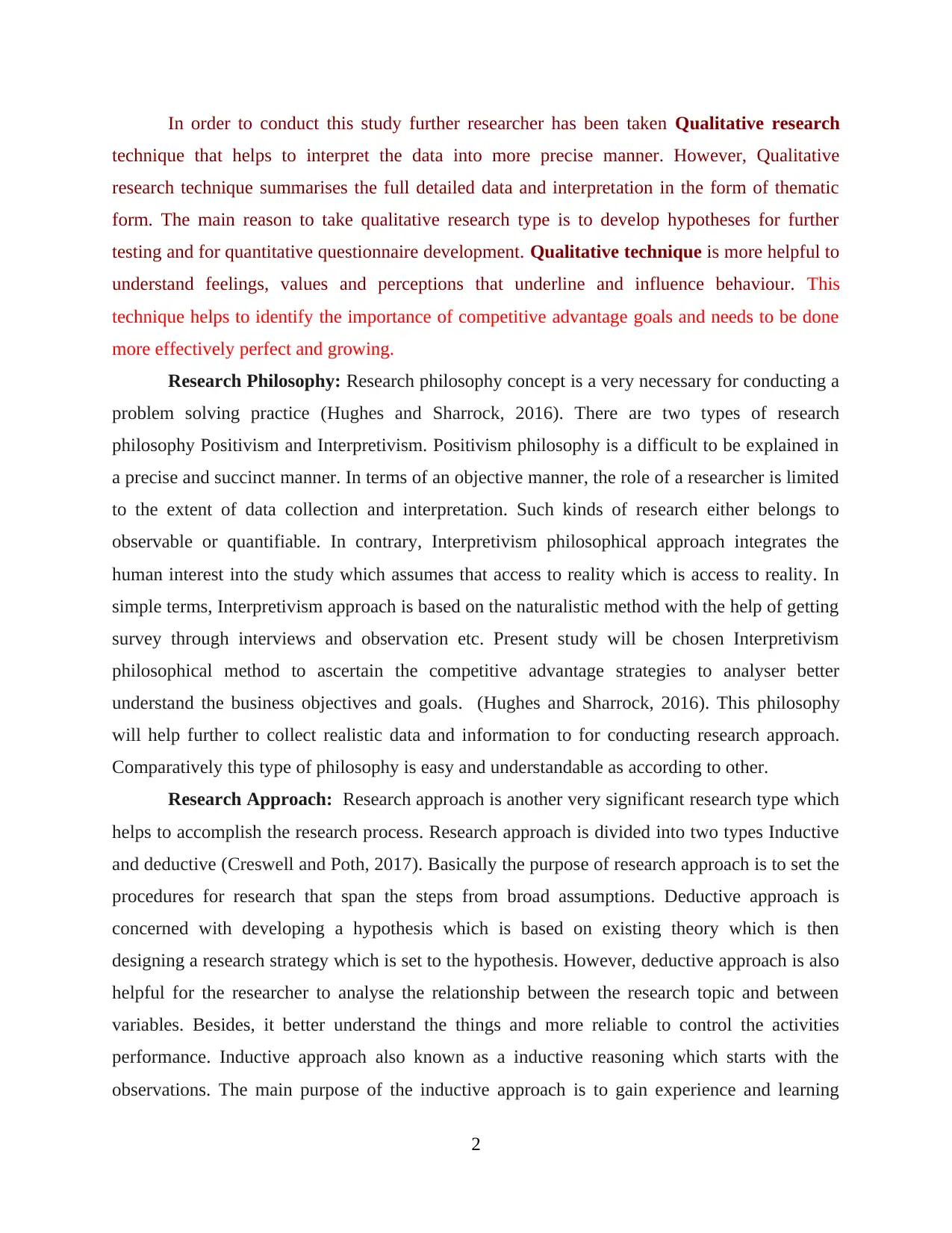
In order to conduct this study further researcher has been taken Qualitative research
technique that helps to interpret the data into more precise manner. However, Qualitative
research technique summarises the full detailed data and interpretation in the form of thematic
form. The main reason to take qualitative research type is to develop hypotheses for further
testing and for quantitative questionnaire development. Qualitative technique is more helpful to
understand feelings, values and perceptions that underline and influence behaviour. This
technique helps to identify the importance of competitive advantage goals and needs to be done
more effectively perfect and growing.
Research Philosophy: Research philosophy concept is a very necessary for conducting a
problem solving practice (Hughes and Sharrock, 2016). There are two types of research
philosophy Positivism and Interpretivism. Positivism philosophy is a difficult to be explained in
a precise and succinct manner. In terms of an objective manner, the role of a researcher is limited
to the extent of data collection and interpretation. Such kinds of research either belongs to
observable or quantifiable. In contrary, Interpretivism philosophical approach integrates the
human interest into the study which assumes that access to reality which is access to reality. In
simple terms, Interpretivism approach is based on the naturalistic method with the help of getting
survey through interviews and observation etc. Present study will be chosen Interpretivism
philosophical method to ascertain the competitive advantage strategies to analyser better
understand the business objectives and goals. (Hughes and Sharrock, 2016). This philosophy
will help further to collect realistic data and information to for conducting research approach.
Comparatively this type of philosophy is easy and understandable as according to other.
Research Approach: Research approach is another very significant research type which
helps to accomplish the research process. Research approach is divided into two types Inductive
and deductive (Creswell and Poth, 2017). Basically the purpose of research approach is to set the
procedures for research that span the steps from broad assumptions. Deductive approach is
concerned with developing a hypothesis which is based on existing theory which is then
designing a research strategy which is set to the hypothesis. However, deductive approach is also
helpful for the researcher to analyse the relationship between the research topic and between
variables. Besides, it better understand the things and more reliable to control the activities
performance. Inductive approach also known as a inductive reasoning which starts with the
observations. The main purpose of the inductive approach is to gain experience and learning
2
technique that helps to interpret the data into more precise manner. However, Qualitative
research technique summarises the full detailed data and interpretation in the form of thematic
form. The main reason to take qualitative research type is to develop hypotheses for further
testing and for quantitative questionnaire development. Qualitative technique is more helpful to
understand feelings, values and perceptions that underline and influence behaviour. This
technique helps to identify the importance of competitive advantage goals and needs to be done
more effectively perfect and growing.
Research Philosophy: Research philosophy concept is a very necessary for conducting a
problem solving practice (Hughes and Sharrock, 2016). There are two types of research
philosophy Positivism and Interpretivism. Positivism philosophy is a difficult to be explained in
a precise and succinct manner. In terms of an objective manner, the role of a researcher is limited
to the extent of data collection and interpretation. Such kinds of research either belongs to
observable or quantifiable. In contrary, Interpretivism philosophical approach integrates the
human interest into the study which assumes that access to reality which is access to reality. In
simple terms, Interpretivism approach is based on the naturalistic method with the help of getting
survey through interviews and observation etc. Present study will be chosen Interpretivism
philosophical method to ascertain the competitive advantage strategies to analyser better
understand the business objectives and goals. (Hughes and Sharrock, 2016). This philosophy
will help further to collect realistic data and information to for conducting research approach.
Comparatively this type of philosophy is easy and understandable as according to other.
Research Approach: Research approach is another very significant research type which
helps to accomplish the research process. Research approach is divided into two types Inductive
and deductive (Creswell and Poth, 2017). Basically the purpose of research approach is to set the
procedures for research that span the steps from broad assumptions. Deductive approach is
concerned with developing a hypothesis which is based on existing theory which is then
designing a research strategy which is set to the hypothesis. However, deductive approach is also
helpful for the researcher to analyse the relationship between the research topic and between
variables. Besides, it better understand the things and more reliable to control the activities
performance. Inductive approach also known as a inductive reasoning which starts with the
observations. The main purpose of the inductive approach is to gain experience and learning
2
Secure Best Marks with AI Grader
Need help grading? Try our AI Grader for instant feedback on your assignments.
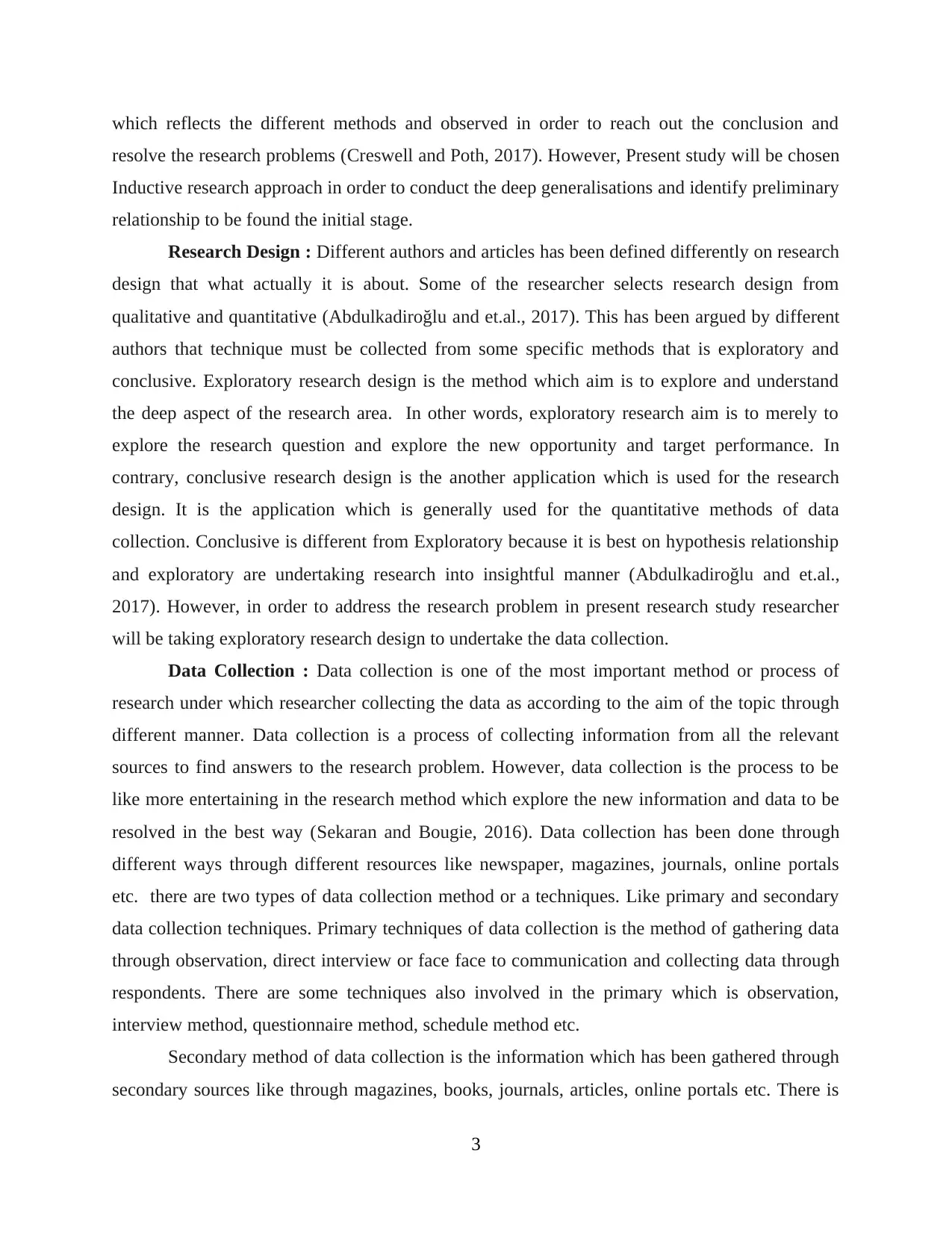
which reflects the different methods and observed in order to reach out the conclusion and
resolve the research problems (Creswell and Poth, 2017). However, Present study will be chosen
Inductive research approach in order to conduct the deep generalisations and identify preliminary
relationship to be found the initial stage.
Research Design : Different authors and articles has been defined differently on research
design that what actually it is about. Some of the researcher selects research design from
qualitative and quantitative (Abdulkadiroğlu and et.al., 2017). This has been argued by different
authors that technique must be collected from some specific methods that is exploratory and
conclusive. Exploratory research design is the method which aim is to explore and understand
the deep aspect of the research area. In other words, exploratory research aim is to merely to
explore the research question and explore the new opportunity and target performance. In
contrary, conclusive research design is the another application which is used for the research
design. It is the application which is generally used for the quantitative methods of data
collection. Conclusive is different from Exploratory because it is best on hypothesis relationship
and exploratory are undertaking research into insightful manner (Abdulkadiroğlu and et.al.,
2017). However, in order to address the research problem in present research study researcher
will be taking exploratory research design to undertake the data collection.
Data Collection : Data collection is one of the most important method or process of
research under which researcher collecting the data as according to the aim of the topic through
different manner. Data collection is a process of collecting information from all the relevant
sources to find answers to the research problem. However, data collection is the process to be
like more entertaining in the research method which explore the new information and data to be
resolved in the best way (Sekaran and Bougie, 2016). Data collection has been done through
different ways through different resources like newspaper, magazines, journals, online portals
etc. there are two types of data collection method or a techniques. Like primary and secondary
data collection techniques. Primary techniques of data collection is the method of gathering data
through observation, direct interview or face face to communication and collecting data through
respondents. There are some techniques also involved in the primary which is observation,
interview method, questionnaire method, schedule method etc.
Secondary method of data collection is the information which has been gathered through
secondary sources like through magazines, books, journals, articles, online portals etc. There is
3
resolve the research problems (Creswell and Poth, 2017). However, Present study will be chosen
Inductive research approach in order to conduct the deep generalisations and identify preliminary
relationship to be found the initial stage.
Research Design : Different authors and articles has been defined differently on research
design that what actually it is about. Some of the researcher selects research design from
qualitative and quantitative (Abdulkadiroğlu and et.al., 2017). This has been argued by different
authors that technique must be collected from some specific methods that is exploratory and
conclusive. Exploratory research design is the method which aim is to explore and understand
the deep aspect of the research area. In other words, exploratory research aim is to merely to
explore the research question and explore the new opportunity and target performance. In
contrary, conclusive research design is the another application which is used for the research
design. It is the application which is generally used for the quantitative methods of data
collection. Conclusive is different from Exploratory because it is best on hypothesis relationship
and exploratory are undertaking research into insightful manner (Abdulkadiroğlu and et.al.,
2017). However, in order to address the research problem in present research study researcher
will be taking exploratory research design to undertake the data collection.
Data Collection : Data collection is one of the most important method or process of
research under which researcher collecting the data as according to the aim of the topic through
different manner. Data collection is a process of collecting information from all the relevant
sources to find answers to the research problem. However, data collection is the process to be
like more entertaining in the research method which explore the new information and data to be
resolved in the best way (Sekaran and Bougie, 2016). Data collection has been done through
different ways through different resources like newspaper, magazines, journals, online portals
etc. there are two types of data collection method or a techniques. Like primary and secondary
data collection techniques. Primary techniques of data collection is the method of gathering data
through observation, direct interview or face face to communication and collecting data through
respondents. There are some techniques also involved in the primary which is observation,
interview method, questionnaire method, schedule method etc.
Secondary method of data collection is the information which has been gathered through
secondary sources like through magazines, books, journals, articles, online portals etc. There is
3
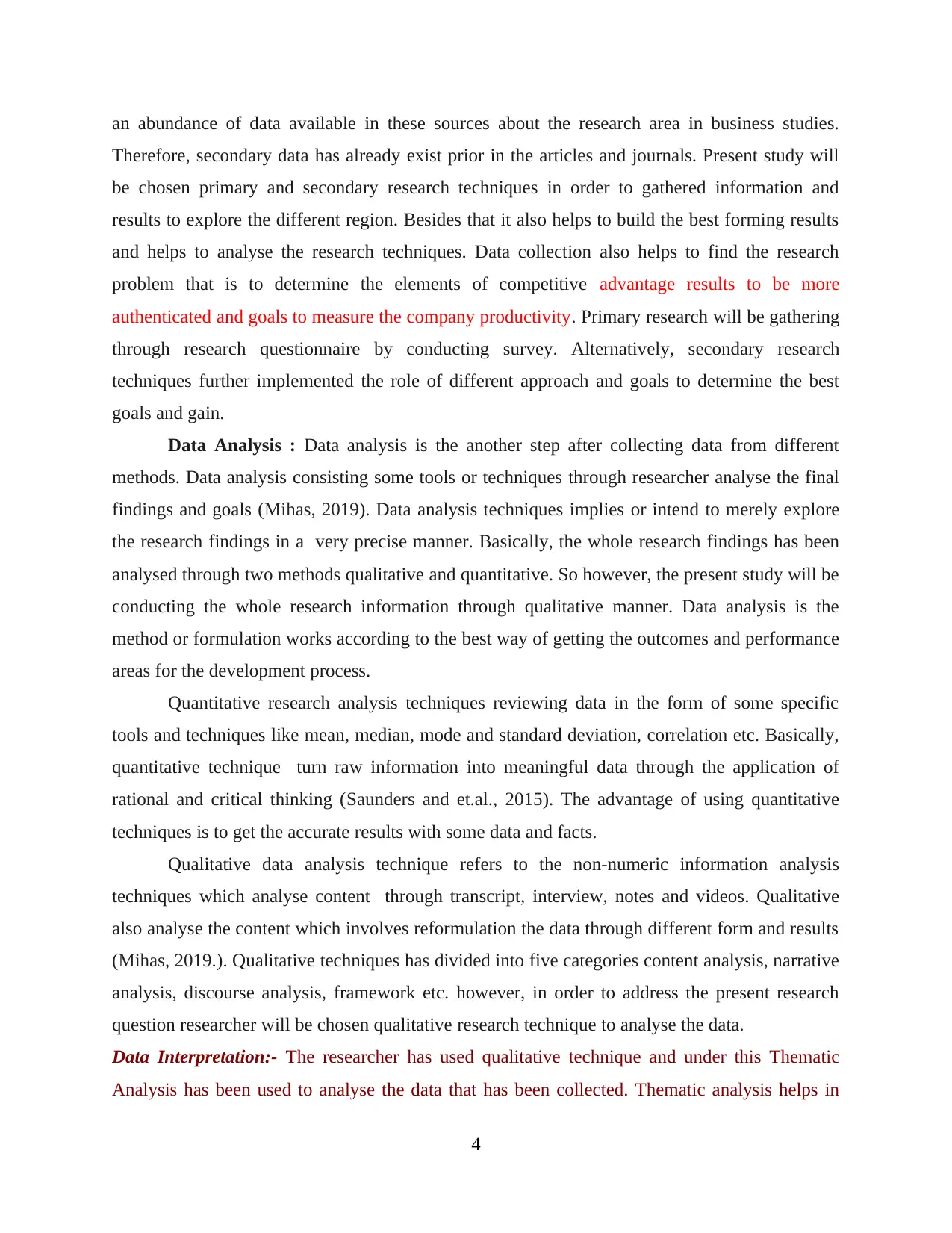
an abundance of data available in these sources about the research area in business studies.
Therefore, secondary data has already exist prior in the articles and journals. Present study will
be chosen primary and secondary research techniques in order to gathered information and
results to explore the different region. Besides that it also helps to build the best forming results
and helps to analyse the research techniques. Data collection also helps to find the research
problem that is to determine the elements of competitive advantage results to be more
authenticated and goals to measure the company productivity. Primary research will be gathering
through research questionnaire by conducting survey. Alternatively, secondary research
techniques further implemented the role of different approach and goals to determine the best
goals and gain.
Data Analysis : Data analysis is the another step after collecting data from different
methods. Data analysis consisting some tools or techniques through researcher analyse the final
findings and goals (Mihas, 2019). Data analysis techniques implies or intend to merely explore
the research findings in a very precise manner. Basically, the whole research findings has been
analysed through two methods qualitative and quantitative. So however, the present study will be
conducting the whole research information through qualitative manner. Data analysis is the
method or formulation works according to the best way of getting the outcomes and performance
areas for the development process.
Quantitative research analysis techniques reviewing data in the form of some specific
tools and techniques like mean, median, mode and standard deviation, correlation etc. Basically,
quantitative technique turn raw information into meaningful data through the application of
rational and critical thinking (Saunders and et.al., 2015). The advantage of using quantitative
techniques is to get the accurate results with some data and facts.
Qualitative data analysis technique refers to the non-numeric information analysis
techniques which analyse content through transcript, interview, notes and videos. Qualitative
also analyse the content which involves reformulation the data through different form and results
(Mihas, 2019.). Qualitative techniques has divided into five categories content analysis, narrative
analysis, discourse analysis, framework etc. however, in order to address the present research
question researcher will be chosen qualitative research technique to analyse the data.
Data Interpretation:- The researcher has used qualitative technique and under this Thematic
Analysis has been used to analyse the data that has been collected. Thematic analysis helps in
4
Therefore, secondary data has already exist prior in the articles and journals. Present study will
be chosen primary and secondary research techniques in order to gathered information and
results to explore the different region. Besides that it also helps to build the best forming results
and helps to analyse the research techniques. Data collection also helps to find the research
problem that is to determine the elements of competitive advantage results to be more
authenticated and goals to measure the company productivity. Primary research will be gathering
through research questionnaire by conducting survey. Alternatively, secondary research
techniques further implemented the role of different approach and goals to determine the best
goals and gain.
Data Analysis : Data analysis is the another step after collecting data from different
methods. Data analysis consisting some tools or techniques through researcher analyse the final
findings and goals (Mihas, 2019). Data analysis techniques implies or intend to merely explore
the research findings in a very precise manner. Basically, the whole research findings has been
analysed through two methods qualitative and quantitative. So however, the present study will be
conducting the whole research information through qualitative manner. Data analysis is the
method or formulation works according to the best way of getting the outcomes and performance
areas for the development process.
Quantitative research analysis techniques reviewing data in the form of some specific
tools and techniques like mean, median, mode and standard deviation, correlation etc. Basically,
quantitative technique turn raw information into meaningful data through the application of
rational and critical thinking (Saunders and et.al., 2015). The advantage of using quantitative
techniques is to get the accurate results with some data and facts.
Qualitative data analysis technique refers to the non-numeric information analysis
techniques which analyse content through transcript, interview, notes and videos. Qualitative
also analyse the content which involves reformulation the data through different form and results
(Mihas, 2019.). Qualitative techniques has divided into five categories content analysis, narrative
analysis, discourse analysis, framework etc. however, in order to address the present research
question researcher will be chosen qualitative research technique to analyse the data.
Data Interpretation:- The researcher has used qualitative technique and under this Thematic
Analysis has been used to analyse the data that has been collected. Thematic analysis helps in
4
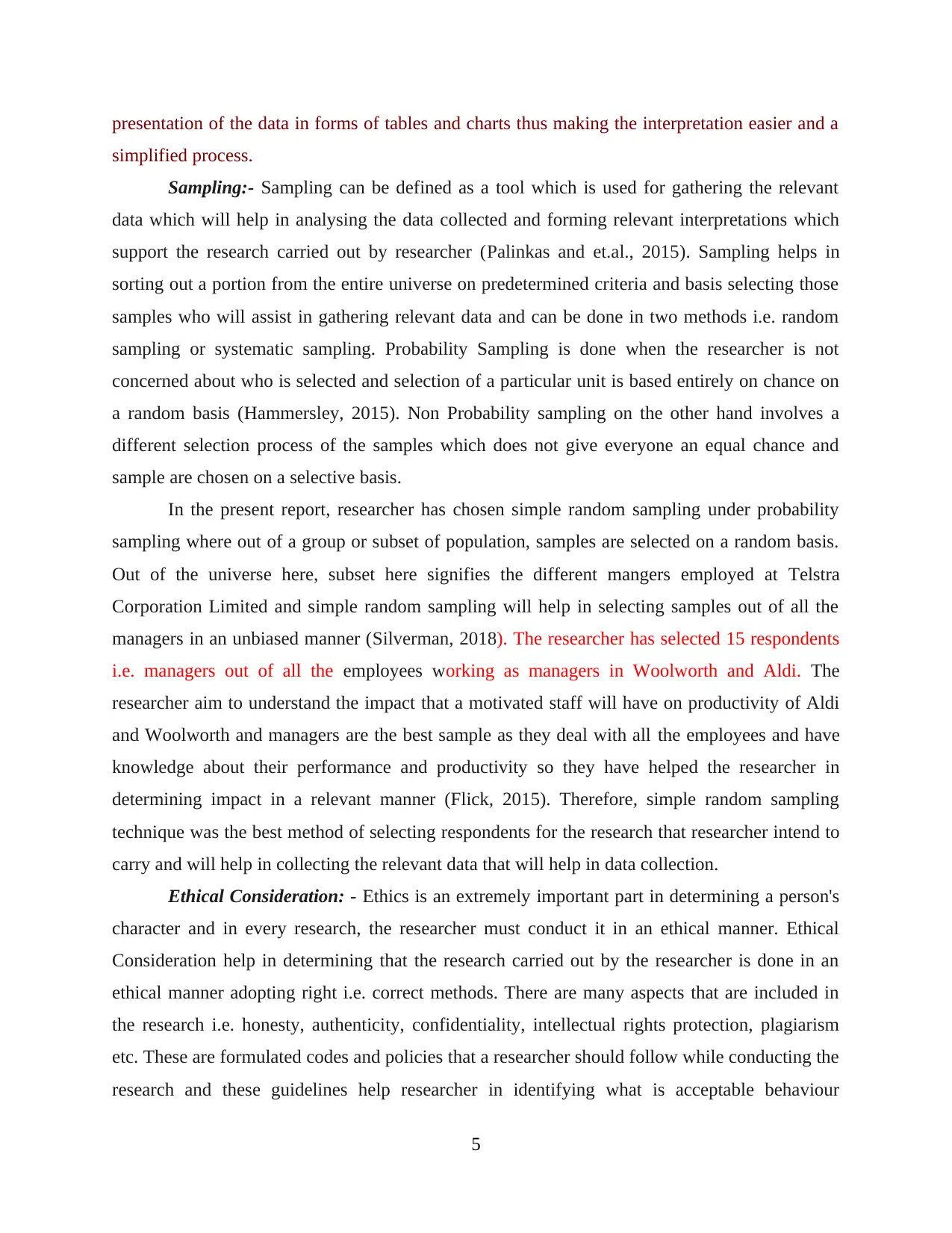
presentation of the data in forms of tables and charts thus making the interpretation easier and a
simplified process.
Sampling:- Sampling can be defined as a tool which is used for gathering the relevant
data which will help in analysing the data collected and forming relevant interpretations which
support the research carried out by researcher (Palinkas and et.al., 2015). Sampling helps in
sorting out a portion from the entire universe on predetermined criteria and basis selecting those
samples who will assist in gathering relevant data and can be done in two methods i.e. random
sampling or systematic sampling. Probability Sampling is done when the researcher is not
concerned about who is selected and selection of a particular unit is based entirely on chance on
a random basis (Hammersley, 2015). Non Probability sampling on the other hand involves a
different selection process of the samples which does not give everyone an equal chance and
sample are chosen on a selective basis.
In the present report, researcher has chosen simple random sampling under probability
sampling where out of a group or subset of population, samples are selected on a random basis.
Out of the universe here, subset here signifies the different mangers employed at Telstra
Corporation Limited and simple random sampling will help in selecting samples out of all the
managers in an unbiased manner (Silverman, 2018). The researcher has selected 15 respondents
i.e. managers out of all the employees working as managers in Woolworth and Aldi. The
researcher aim to understand the impact that a motivated staff will have on productivity of Aldi
and Woolworth and managers are the best sample as they deal with all the employees and have
knowledge about their performance and productivity so they have helped the researcher in
determining impact in a relevant manner (Flick, 2015). Therefore, simple random sampling
technique was the best method of selecting respondents for the research that researcher intend to
carry and will help in collecting the relevant data that will help in data collection.
Ethical Consideration: - Ethics is an extremely important part in determining a person's
character and in every research, the researcher must conduct it in an ethical manner. Ethical
Consideration help in determining that the research carried out by the researcher is done in an
ethical manner adopting right i.e. correct methods. There are many aspects that are included in
the research i.e. honesty, authenticity, confidentiality, intellectual rights protection, plagiarism
etc. These are formulated codes and policies that a researcher should follow while conducting the
research and these guidelines help researcher in identifying what is acceptable behaviour
5
simplified process.
Sampling:- Sampling can be defined as a tool which is used for gathering the relevant
data which will help in analysing the data collected and forming relevant interpretations which
support the research carried out by researcher (Palinkas and et.al., 2015). Sampling helps in
sorting out a portion from the entire universe on predetermined criteria and basis selecting those
samples who will assist in gathering relevant data and can be done in two methods i.e. random
sampling or systematic sampling. Probability Sampling is done when the researcher is not
concerned about who is selected and selection of a particular unit is based entirely on chance on
a random basis (Hammersley, 2015). Non Probability sampling on the other hand involves a
different selection process of the samples which does not give everyone an equal chance and
sample are chosen on a selective basis.
In the present report, researcher has chosen simple random sampling under probability
sampling where out of a group or subset of population, samples are selected on a random basis.
Out of the universe here, subset here signifies the different mangers employed at Telstra
Corporation Limited and simple random sampling will help in selecting samples out of all the
managers in an unbiased manner (Silverman, 2018). The researcher has selected 15 respondents
i.e. managers out of all the employees working as managers in Woolworth and Aldi. The
researcher aim to understand the impact that a motivated staff will have on productivity of Aldi
and Woolworth and managers are the best sample as they deal with all the employees and have
knowledge about their performance and productivity so they have helped the researcher in
determining impact in a relevant manner (Flick, 2015). Therefore, simple random sampling
technique was the best method of selecting respondents for the research that researcher intend to
carry and will help in collecting the relevant data that will help in data collection.
Ethical Consideration: - Ethics is an extremely important part in determining a person's
character and in every research, the researcher must conduct it in an ethical manner. Ethical
Consideration help in determining that the research carried out by the researcher is done in an
ethical manner adopting right i.e. correct methods. There are many aspects that are included in
the research i.e. honesty, authenticity, confidentiality, intellectual rights protection, plagiarism
etc. These are formulated codes and policies that a researcher should follow while conducting the
research and these guidelines help researcher in identifying what is acceptable behaviour
5
Paraphrase This Document
Need a fresh take? Get an instant paraphrase of this document with our AI Paraphraser
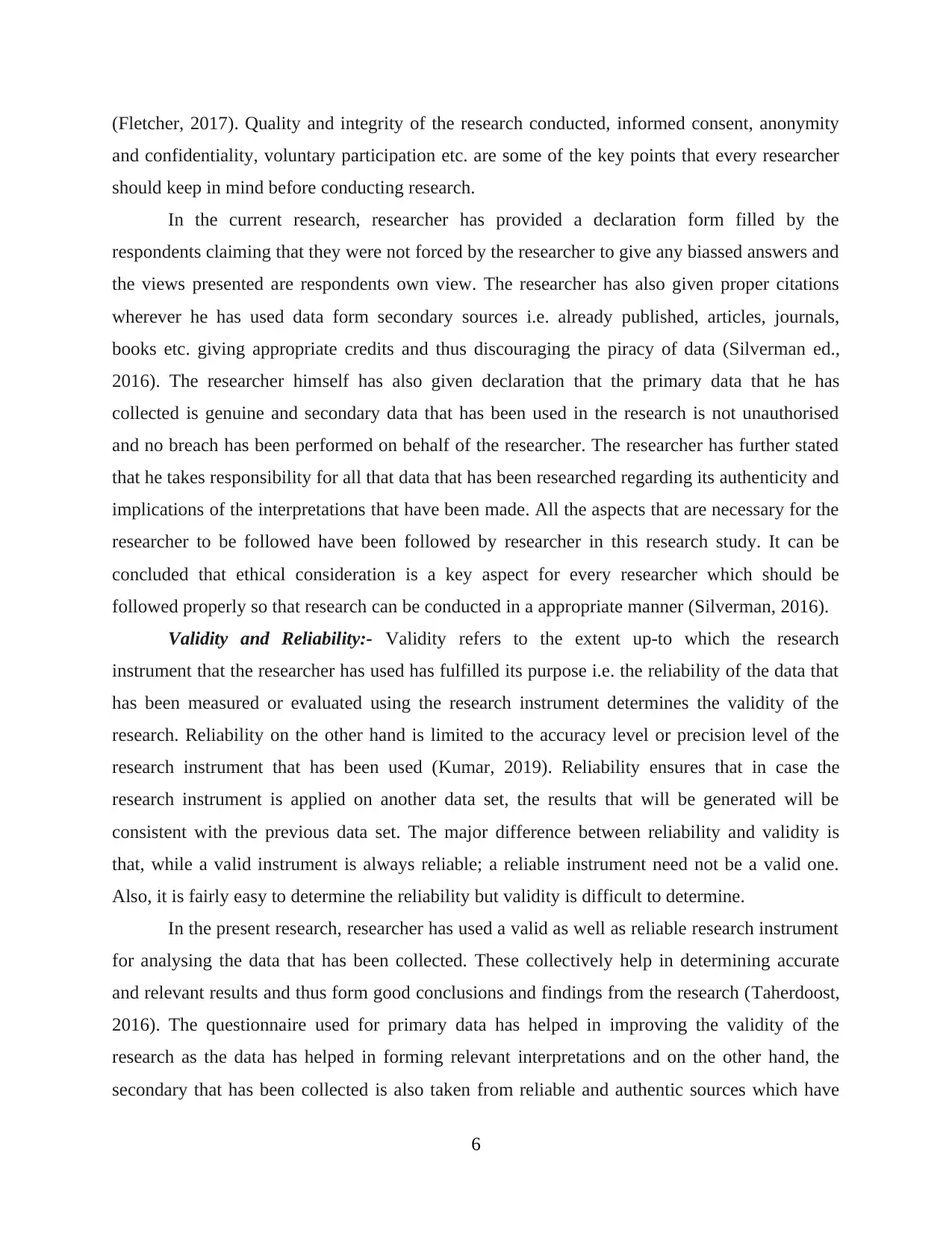
(Fletcher, 2017). Quality and integrity of the research conducted, informed consent, anonymity
and confidentiality, voluntary participation etc. are some of the key points that every researcher
should keep in mind before conducting research.
In the current research, researcher has provided a declaration form filled by the
respondents claiming that they were not forced by the researcher to give any biassed answers and
the views presented are respondents own view. The researcher has also given proper citations
wherever he has used data form secondary sources i.e. already published, articles, journals,
books etc. giving appropriate credits and thus discouraging the piracy of data (Silverman ed.,
2016). The researcher himself has also given declaration that the primary data that he has
collected is genuine and secondary data that has been used in the research is not unauthorised
and no breach has been performed on behalf of the researcher. The researcher has further stated
that he takes responsibility for all that data that has been researched regarding its authenticity and
implications of the interpretations that have been made. All the aspects that are necessary for the
researcher to be followed have been followed by researcher in this research study. It can be
concluded that ethical consideration is a key aspect for every researcher which should be
followed properly so that research can be conducted in a appropriate manner (Silverman, 2016).
Validity and Reliability:- Validity refers to the extent up-to which the research
instrument that the researcher has used has fulfilled its purpose i.e. the reliability of the data that
has been measured or evaluated using the research instrument determines the validity of the
research. Reliability on the other hand is limited to the accuracy level or precision level of the
research instrument that has been used (Kumar, 2019). Reliability ensures that in case the
research instrument is applied on another data set, the results that will be generated will be
consistent with the previous data set. The major difference between reliability and validity is
that, while a valid instrument is always reliable; a reliable instrument need not be a valid one.
Also, it is fairly easy to determine the reliability but validity is difficult to determine.
In the present research, researcher has used a valid as well as reliable research instrument
for analysing the data that has been collected. These collectively help in determining accurate
and relevant results and thus form good conclusions and findings from the research (Taherdoost,
2016). The questionnaire used for primary data has helped in improving the validity of the
research as the data has helped in forming relevant interpretations and on the other hand, the
secondary that has been collected is also taken from reliable and authentic sources which have
6
and confidentiality, voluntary participation etc. are some of the key points that every researcher
should keep in mind before conducting research.
In the current research, researcher has provided a declaration form filled by the
respondents claiming that they were not forced by the researcher to give any biassed answers and
the views presented are respondents own view. The researcher has also given proper citations
wherever he has used data form secondary sources i.e. already published, articles, journals,
books etc. giving appropriate credits and thus discouraging the piracy of data (Silverman ed.,
2016). The researcher himself has also given declaration that the primary data that he has
collected is genuine and secondary data that has been used in the research is not unauthorised
and no breach has been performed on behalf of the researcher. The researcher has further stated
that he takes responsibility for all that data that has been researched regarding its authenticity and
implications of the interpretations that have been made. All the aspects that are necessary for the
researcher to be followed have been followed by researcher in this research study. It can be
concluded that ethical consideration is a key aspect for every researcher which should be
followed properly so that research can be conducted in a appropriate manner (Silverman, 2016).
Validity and Reliability:- Validity refers to the extent up-to which the research
instrument that the researcher has used has fulfilled its purpose i.e. the reliability of the data that
has been measured or evaluated using the research instrument determines the validity of the
research. Reliability on the other hand is limited to the accuracy level or precision level of the
research instrument that has been used (Kumar, 2019). Reliability ensures that in case the
research instrument is applied on another data set, the results that will be generated will be
consistent with the previous data set. The major difference between reliability and validity is
that, while a valid instrument is always reliable; a reliable instrument need not be a valid one.
Also, it is fairly easy to determine the reliability but validity is difficult to determine.
In the present research, researcher has used a valid as well as reliable research instrument
for analysing the data that has been collected. These collectively help in determining accurate
and relevant results and thus form good conclusions and findings from the research (Taherdoost,
2016). The questionnaire used for primary data has helped in improving the validity of the
research as the data has helped in forming relevant interpretations and on the other hand, the
secondary that has been collected is also taken from reliable and authentic sources which have
6
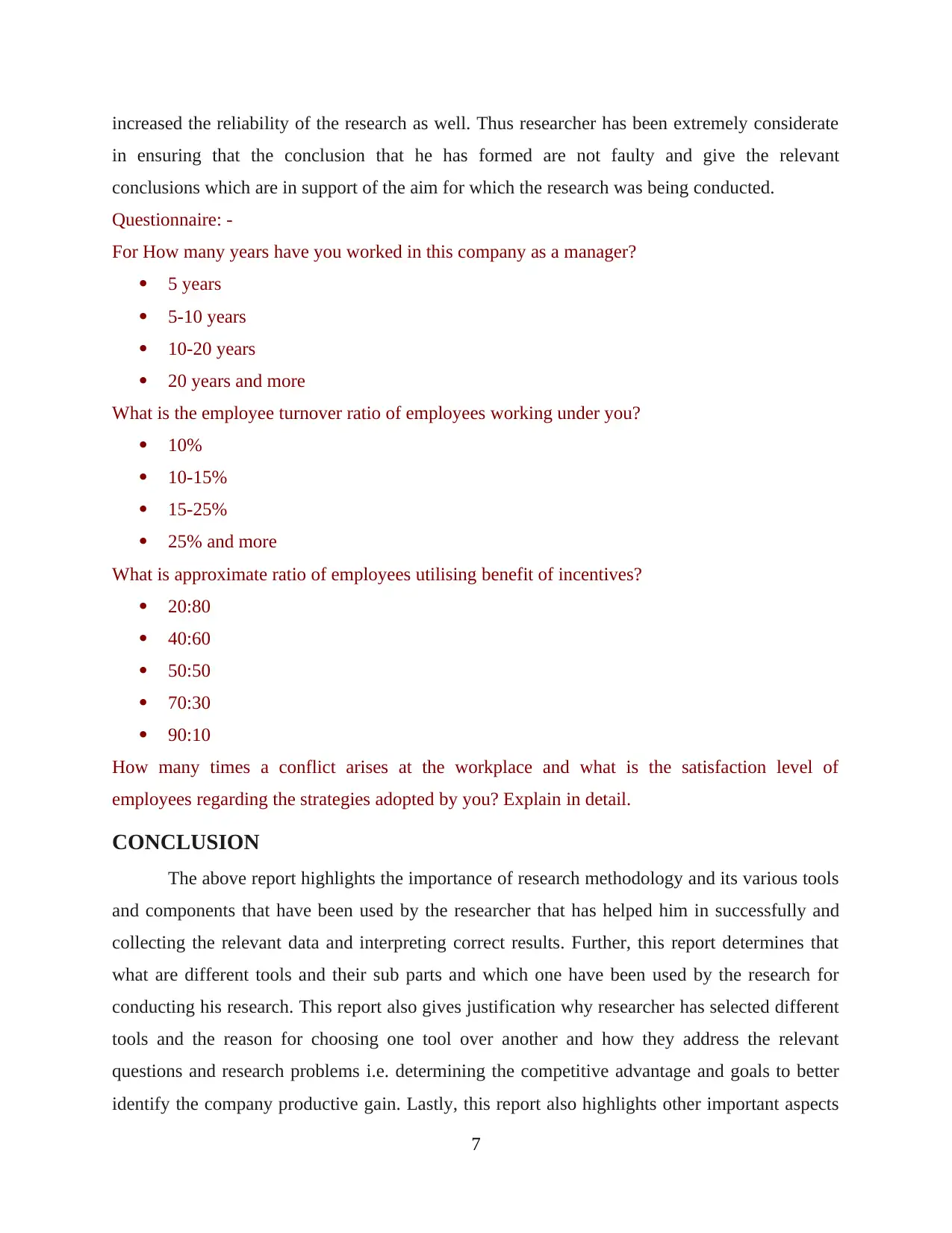
increased the reliability of the research as well. Thus researcher has been extremely considerate
in ensuring that the conclusion that he has formed are not faulty and give the relevant
conclusions which are in support of the aim for which the research was being conducted.
Questionnaire: -
For How many years have you worked in this company as a manager?
5 years
5-10 years
10-20 years
20 years and more
What is the employee turnover ratio of employees working under you?
10%
10-15%
15-25%
25% and more
What is approximate ratio of employees utilising benefit of incentives?
20:80
40:60
50:50
70:30
90:10
How many times a conflict arises at the workplace and what is the satisfaction level of
employees regarding the strategies adopted by you? Explain in detail.
CONCLUSION
The above report highlights the importance of research methodology and its various tools
and components that have been used by the researcher that has helped him in successfully and
collecting the relevant data and interpreting correct results. Further, this report determines that
what are different tools and their sub parts and which one have been used by the research for
conducting his research. This report also gives justification why researcher has selected different
tools and the reason for choosing one tool over another and how they address the relevant
questions and research problems i.e. determining the competitive advantage and goals to better
identify the company productive gain. Lastly, this report also highlights other important aspects
7
in ensuring that the conclusion that he has formed are not faulty and give the relevant
conclusions which are in support of the aim for which the research was being conducted.
Questionnaire: -
For How many years have you worked in this company as a manager?
5 years
5-10 years
10-20 years
20 years and more
What is the employee turnover ratio of employees working under you?
10%
10-15%
15-25%
25% and more
What is approximate ratio of employees utilising benefit of incentives?
20:80
40:60
50:50
70:30
90:10
How many times a conflict arises at the workplace and what is the satisfaction level of
employees regarding the strategies adopted by you? Explain in detail.
CONCLUSION
The above report highlights the importance of research methodology and its various tools
and components that have been used by the researcher that has helped him in successfully and
collecting the relevant data and interpreting correct results. Further, this report determines that
what are different tools and their sub parts and which one have been used by the research for
conducting his research. This report also gives justification why researcher has selected different
tools and the reason for choosing one tool over another and how they address the relevant
questions and research problems i.e. determining the competitive advantage and goals to better
identify the company productive gain. Lastly, this report also highlights other important aspects
7
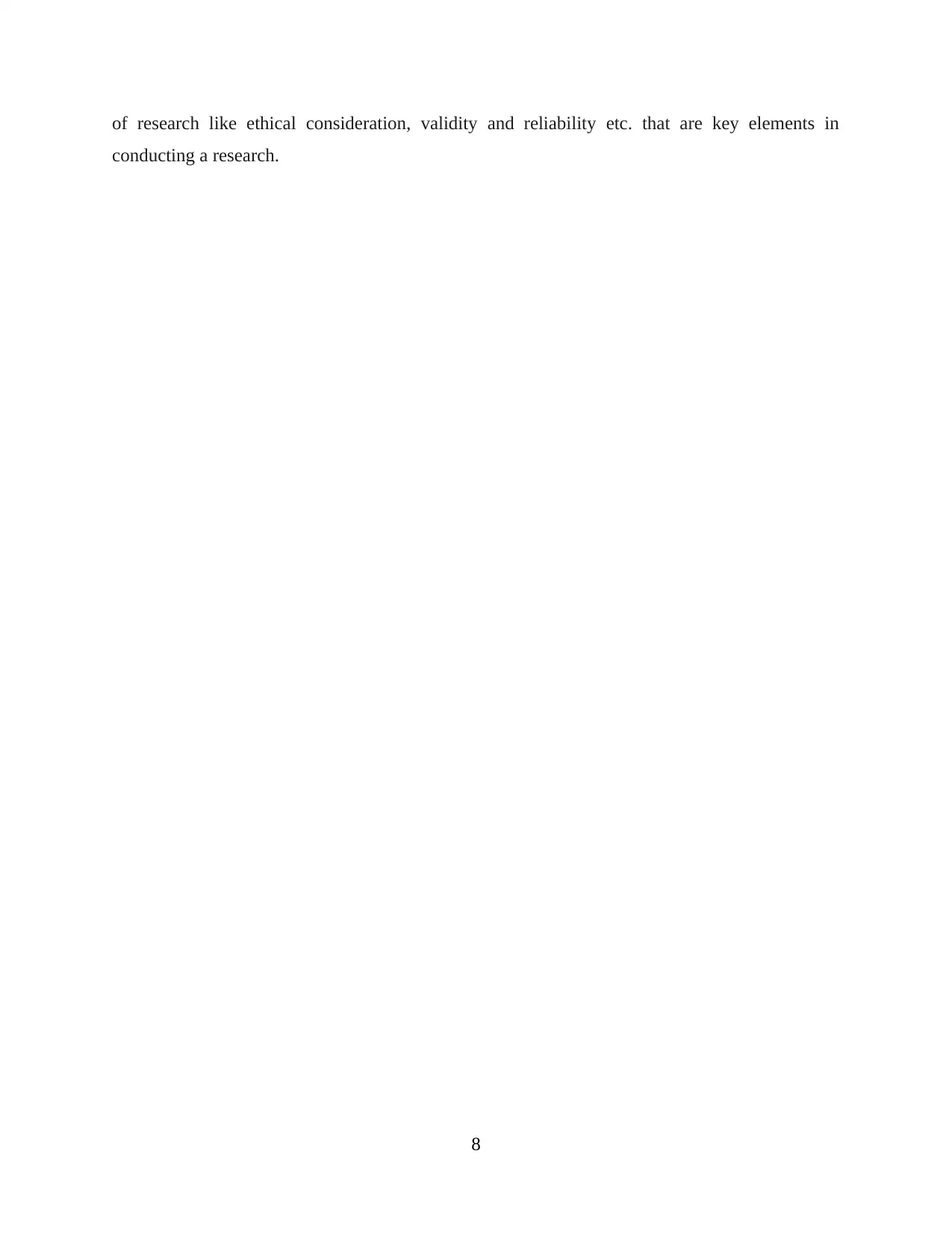
of research like ethical consideration, validity and reliability etc. that are key elements in
conducting a research.
8
conducting a research.
8
Secure Best Marks with AI Grader
Need help grading? Try our AI Grader for instant feedback on your assignments.
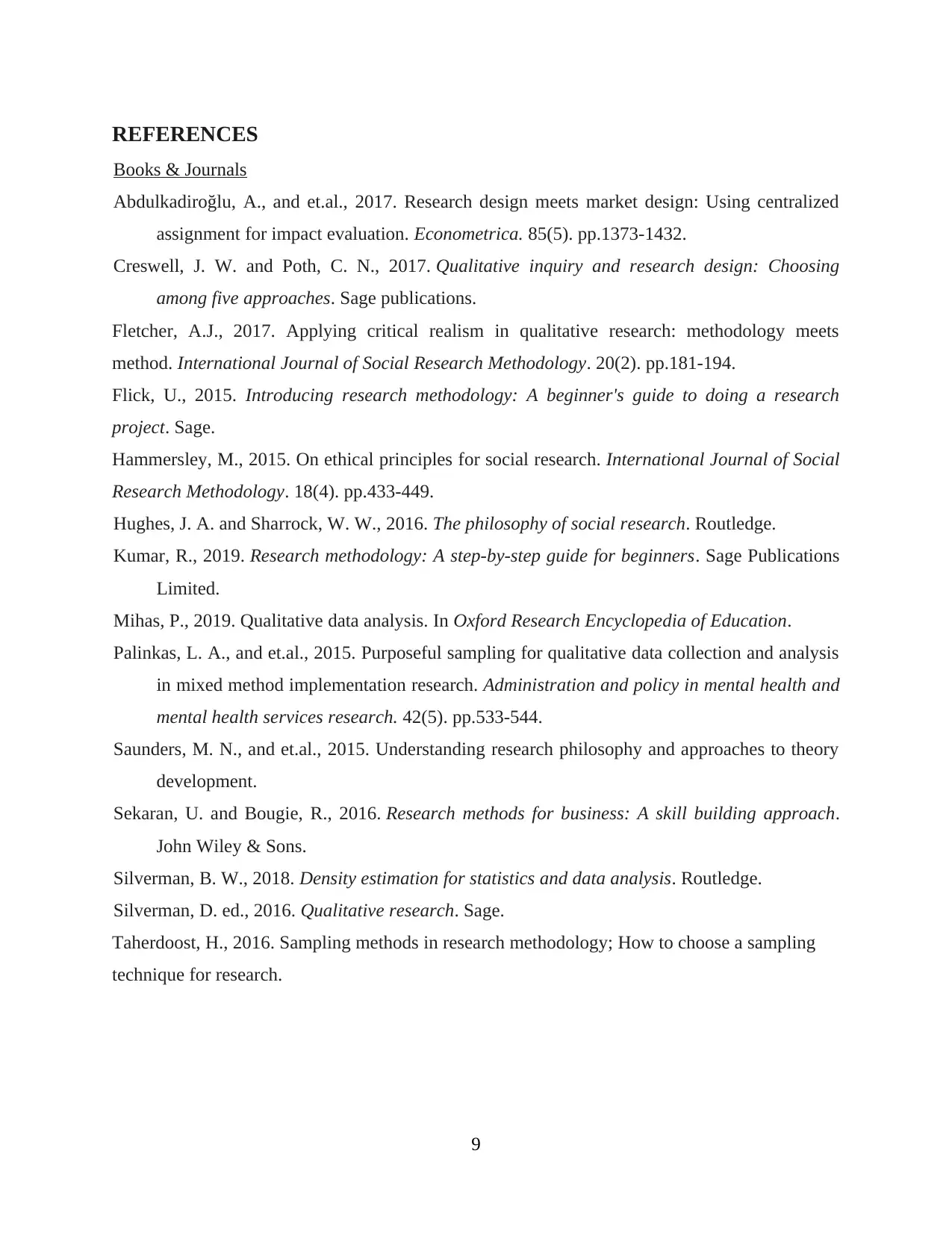
REFERENCES
Books & Journals
Abdulkadiroğlu, A., and et.al., 2017. Research design meets market design: Using centralized
assignment for impact evaluation. Econometrica. 85(5). pp.1373-1432.
Creswell, J. W. and Poth, C. N., 2017. Qualitative inquiry and research design: Choosing
among five approaches. Sage publications.
Fletcher, A.J., 2017. Applying critical realism in qualitative research: methodology meets
method. International Journal of Social Research Methodology. 20(2). pp.181-194.
Flick, U., 2015. Introducing research methodology: A beginner's guide to doing a research
project. Sage.
Hammersley, M., 2015. On ethical principles for social research. International Journal of Social
Research Methodology. 18(4). pp.433-449.
Hughes, J. A. and Sharrock, W. W., 2016. The philosophy of social research. Routledge.
Kumar, R., 2019. Research methodology: A step-by-step guide for beginners. Sage Publications
Limited.
Mihas, P., 2019. Qualitative data analysis. In Oxford Research Encyclopedia of Education.
Palinkas, L. A., and et.al., 2015. Purposeful sampling for qualitative data collection and analysis
in mixed method implementation research. Administration and policy in mental health and
mental health services research. 42(5). pp.533-544.
Saunders, M. N., and et.al., 2015. Understanding research philosophy and approaches to theory
development.
Sekaran, U. and Bougie, R., 2016. Research methods for business: A skill building approach.
John Wiley & Sons.
Silverman, B. W., 2018. Density estimation for statistics and data analysis. Routledge.
Silverman, D. ed., 2016. Qualitative research. Sage.
Taherdoost, H., 2016. Sampling methods in research methodology; How to choose a sampling
technique for research.
9
Books & Journals
Abdulkadiroğlu, A., and et.al., 2017. Research design meets market design: Using centralized
assignment for impact evaluation. Econometrica. 85(5). pp.1373-1432.
Creswell, J. W. and Poth, C. N., 2017. Qualitative inquiry and research design: Choosing
among five approaches. Sage publications.
Fletcher, A.J., 2017. Applying critical realism in qualitative research: methodology meets
method. International Journal of Social Research Methodology. 20(2). pp.181-194.
Flick, U., 2015. Introducing research methodology: A beginner's guide to doing a research
project. Sage.
Hammersley, M., 2015. On ethical principles for social research. International Journal of Social
Research Methodology. 18(4). pp.433-449.
Hughes, J. A. and Sharrock, W. W., 2016. The philosophy of social research. Routledge.
Kumar, R., 2019. Research methodology: A step-by-step guide for beginners. Sage Publications
Limited.
Mihas, P., 2019. Qualitative data analysis. In Oxford Research Encyclopedia of Education.
Palinkas, L. A., and et.al., 2015. Purposeful sampling for qualitative data collection and analysis
in mixed method implementation research. Administration and policy in mental health and
mental health services research. 42(5). pp.533-544.
Saunders, M. N., and et.al., 2015. Understanding research philosophy and approaches to theory
development.
Sekaran, U. and Bougie, R., 2016. Research methods for business: A skill building approach.
John Wiley & Sons.
Silverman, B. W., 2018. Density estimation for statistics and data analysis. Routledge.
Silverman, D. ed., 2016. Qualitative research. Sage.
Taherdoost, H., 2016. Sampling methods in research methodology; How to choose a sampling
technique for research.
9

10
1 out of 12
Related Documents
Your All-in-One AI-Powered Toolkit for Academic Success.
+13062052269
info@desklib.com
Available 24*7 on WhatsApp / Email
![[object Object]](/_next/static/media/star-bottom.7253800d.svg)
Unlock your academic potential
© 2024 | Zucol Services PVT LTD | All rights reserved.




